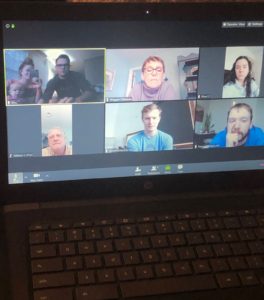
John 9:1-41
I read a story in the news recently about a woman named Marion who has lived all her life with a severe hearing impairment. Then, in her 40’s she began losing her vision too. At first, she was devastated, but then she decided that since she was still alive, she would start dancing.
And then she started teaching other visually impaired people to dance. She leads classes of blind people, like herself, where they learn to do line dances. Most of them are over the age of 60. Like their teacher, Marion, they began losing their vision later in life, so they have memories of seeing. Like Marion, they have learned to find other ways of seeing. Dancing together is one.
For anyone who was born blind, like the young man in this gospel story, other ways of seeing are the norm. I wonder if that is why this young man is able to see things that others cannot see.
To read the story in John’s gospel you have to suspend judgment and just hear it. Because the people in the story are offering starkly different narratives about what’s going on. In the beginning, John does tell us, plainly, what happened, so let’s begin with that: Jesus approached the blind man, made some muddy paste and applied it to his eyes. He instructed the man to go wash it off and when he did he was able to see. So, that’s clear enough, right?
But that’s only the beginning of the story. Because then the neighbors and the Pharisees enter and they tell their versions of the story.
The neighbors say: This man who was blind but now sees? He is not the man you might think he is. He is not the young man we all knew as blind. Because that is not possible. This must be a different man.
The young man, however, continues to insist he really is himself. And he is not backing off his story about the guy who came along, put mud on his eyes and healed him. This young man won’t be gaslighted by anyone; he persists in speaking the true as he experienced it. Which seems to make trouble for everyone else.
Then the Pharisees are asked to weigh in, so they begin to interrogate the young man about how this happened. They are looking for the flaw in the young man’s statement, and they find it.
Aha! The man who healed you performed this act on the sabbath. So he is clearly a sinner. Therefore, this cannot be an act of God. Case closed.
What that means about his ability to see is not clear, but at least it’s a distraction.
Meanwhile, the neighbors go to question the young man’s parents because now they seem to think now that the young man and his family have been playing them for fools all these years, pretending that he is blind. Because if he can see now, then it is not possible that he was ever actually blind.
This is a story about a whole lot of seeing people refusing to see what is right before their eyes. The only one in this story who can see clearly turns out to be the one who was born blind.
It is a story that asks us to look beneath the surface level and really examine what it means to see – to perceive – truth. And for all of us, regardless of what kind of vision we have, it involves going beyond what we think we already know. It involves being able to see what we have never seen before.
In these last few weeks, we have been asked to envision a reality that we have a very hard time imagining, let alone believing could actually happen. Several weeks ago, an official from the CDC addressed the public and told us to be prepared to have our lives seriously disrupted. She said we should expect to have schools closed and work interrupted, and all kinds of normal activities stopped for a period of time.
When she said this, just a few weeks ago, none of us wanted to believe it. Many of us denied that it would happen. Why? Because we had never seen it happen before.
But it did happen, didn’t it? And yet, throughout these weeks, while we have seen one disruption after another, many of us still insisted that it was overblown. That people were overreacting. That the virus was really no worse than the common cold. That the flu virus kills many more people than COVID-19, just look at the statistics. We have insisted that what we are hearing is not real. Why? Because we can’t see it yet.
Our eyes are not trained to see what might happen. We see only what is before us now, and we can only imagine what we have seen before. Like the neighbors of the young blind man who tried to make sense of things by deciding that the young man was never actually blind. Like the Pharisees who are trying to get a grip on their lives by picking out holes in the logic so they can deny the truth that is standing before them.
They focus on the technical problems rather than the miracle standing before them.
When I say this, I do not mean to infer that COVID-19 is a miracle. It’s not. It’s a disease that has upended our lives completely. It has increased our stress levels dramatically. People who struggle with anxiety are finding themselves challenged to stay calm and present. People who struggle with depression are faced with the challenge of keeping themselves lifted up and functioning while their routines are deeply disrupted. People are alone and lonely. People are afraid – of all kinds of loss. The loss of health, of life, of our loved ones, of our security. We are seeing things happen now that we have not really been able to imagine happening to us before.
Covid-19 is not a miracle. It is not an act of God. People of faith, we do not believe God intentionally inflicts us with pandemic. But we do believe that God is present and active in every trial we face.
How can you see God at work here and now?
Yes, we are being asked to see beyond our ordinary ways of seeing.
We are re-imagining how we do everything. How we work, how we learn, how we stay in touch with loved ones, how we care for one another. How we hold and even strengthen the bonds of community. We are grateful for the internet in a whole new way. And, surprisingly, we are rediscovering the beauty of neighborhood.
In my old hometown, musicians are taking their instruments out on their porches and providing live music for the neighbors. Neighborhoods are holding singalongs as they open their windows or get out on their front stoops and sing and dance.
Here and other places, neighbors are checking in on one another, making sure people have what they need and that they are okay. And right here at this church, a few people have been getting together every day to give sack lunches to anyone in the neighborhood who comes to our parking lot to get one. And there is so much more.
Maybe you are calling people you don’t normally call, just to hear their voices and tell them you love them. It’s a good idea. Maybe you are rediscovering the art of letter writing, to reach out to people far away with something they can hold in their hand. It’s a good idea. How many ways can we find to love and care for one another in this time of COVID-19?
In this era of social distancing how can we connect?
The message of the story that I hear today is this: sometimes you need to find completely new ways of seeing in order to avoid total blindness. Like the blind woman Marion who dances, and all those who dance with her. They can’t see one another the way we normally see. But dancing together they see one another differently – without fear, without inhibitions.
The message for us, living in a time of pandemic is this: let us keep our hearts open, our ears open, our minds open, as well as our eyes open. Look to see how God is with us through all of this, guiding us to love our neighbors and ourselves with the same love God has for us.
______________________________________________
Photo Credit: Kira Fischer, Family Zoom
